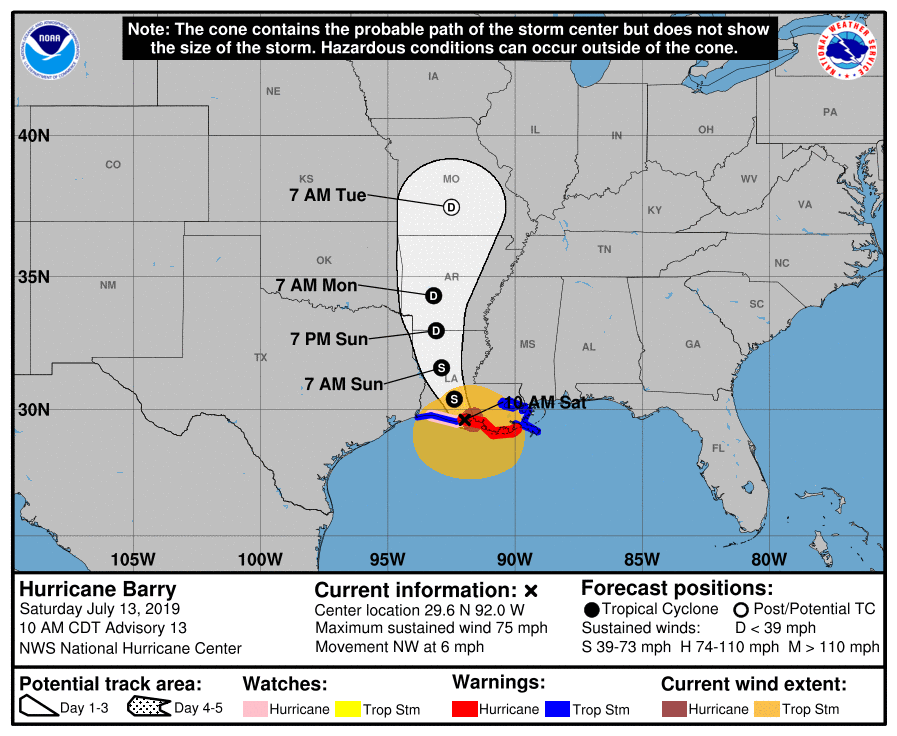


Further south in Mobile County, coastal flooding led to water over the road north of the Dog River Bridge and Shell Belt Road and Coden Belt Road in Bayou La Batre became impassable due to water covering the road. Minor coastal flooding was also observed around Weeks Bay, especially near Pelican Point and Isle of the Pines. Water covered the Causeway over Mobile Bay, which led to the closure of the east bound lanes and closure of the exit/entrance ramps to the I-10 Bayway. After the water receded, Bienville Blvd had spots with 2-3 feet of sand while numerous side streets had several feet of sand covering the road.Ĭoastal flooding also led to water covering parts of the Cochrane Causeway and several low-lying roads near the coast in downtown Mobile. At times, water was 1-2 feet deep along Bienville Blvd. Wave run-up resulted in coastal flooding that began along Bienville Blvd on the west end of Dauphin Island (Mobile County) a few days before landfall of Barry.
#Barry hurricane track series#
Several of the time series plots from the NOAA/NOS/CO-OPS tide gauges across coastal Alabama and northwest Florida can be viewed below.Ĭoastal flooding (less than 3 feet) was observed in several locations across the coast with the peak inundations listed in the table below. Official NOAA/NOS/CO-OPS tide gauges were used to measure the maximum storm surge and storm tide across the area during Hurricane Barry. The locations are noted in miles from the nearest city or community.įor more information on CoCoRaHS rainfall totals and the CoCoRaHS program, visit our CoCoRaHS rainfall website from this event. Storm total rainfall amounts shown below are sorted in order from highest observed totals to lowest for each county's sites. The list includes rainfall amounts from the CoCoRaHS network (Community Collaborative Rain, Hail, & Snow Network), wh ich is a group of volunteers working together to measure precipitation, along with National Weather Service ASOS and COOP sites marked as (A) and (C) respectively. Storm total rainfall amounts from Friday, July 12th through Monday, July 15th are listed in the table below. Heavy rainfall from the outer rain bands of Hurricane Barry led to standing water and flooding in a few communities predominantly near the coast. The axis of heaviest rain extended through our southeast Mississippi Counties and into Mobile and Baldwin Counties in Alabama. The highest storm total rainfall amount in our area was 8.36" near the city of Fairhope in Baldwin County, AL with numerous reports of 5+" across the western half of the area. The animated graphic to the right, a compilation of the daily rainfall plots from NWS Birmingham, shows the gradient in storm total rainfall amounts from west to east across our counties in Alabama and Florida.

However, several outer rain bands set-up across the western half of the NWS Mobile/Pensacola county warning area, which led to high rainfall amounts. Jump to - Rainfall, Coastal Flooding, Wind, or Additional Information sections.ĭue to Hurricane Barry making landfall west of our area, the axis of heaviest rains also occurred further west of the local area. The majority of this document will focus on the impacts from coastal flooding and rainfall across southeast Mississippi, southwest Alabama and northwest Florida. Hurricane Barry made landfall west of our area (coastal Louisiana). Summary of all Local Storm Reports (LSRs) across the area during Hurricane Barry and LSRs across the region during Barry. Hurricane Barry (2019), formed off the U.S.There were no deaths locally that were directly related to Hurricane Barry.Tropical Storm Barry (2013), made landfall in Belize as a tropical depression before emerging into the Bay of Campeche and then making landfall in eastern Mexico.Tropical Storm Barry (2007), short-lived tropical storm that made landfall in western Florida.Tropical Storm Barry (2001), made landfall in Florida, causing two deaths and $30 million in damage.Tropical Storm Barry (1995), formed off South Carolina then moved north, making landfall on eastern tip of Nova Scotia, causing no damage.Tropical Storm Barry (1989), dissipated in the mid-Atlantic without threatening land.Hurricane Barry (1983), made landfall on Florida as a tropical storm, weakened to a depression before crossing, strengthened into a hurricane after exiting into the Gulf of Mexico later struck Mexico, causing some damage.
The name Barry has been used for seven tropical cyclones in the Atlantic Ocean and for one in the Australian Region.


 0 kommentar(er)
0 kommentar(er)
